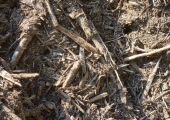That is great progress! I think your dirt needs help to become soil. Fortunately our resident soil scientist can help you out! Doctor Redhawk has a collection of threads here on permies to help us build our soils.
Here is the link to the master list of threads.
https://permies.com/wiki/77424/List-Bryant-RedHawk-Epic-Soil?OWASP_CSRFTOKEN=NECL-OKMT-VEE1-2HMC-C77X-RHYO-7H9X-YRGJ#708227
That list is rather overwhelming, so I grabbed some excerpts... He has taught the need for fungal and good bacterial growth in our soils for good plant growth. In this thread
https://permies.com/t/86117/Bacteria-Fungi-Nematodes a mushroom slurry is recommended for fungal growth. Recipe: Whatever fungal growth you can find in your surroundings, or perhaps a package of mushrooms from the grocery store chopped up by a blender with water and poured out in the area you wish to improve.
The following are selected excerpts from this thread:
https://permies.com/t/67969/quest-super-soil
“…Vegetables, we now know, are more bacterial oriented plants except for some of the root vegetables which seem to call both bacteria and fungi to their root systems.
We know that plants use photosynthesis to build sugar compounds and that these sugars can be simple or complex molecules.
We also know that plant exudates are comprised of these simple sugars and the complex sugars and that each one calls into action different organisms (either bacterial organisms or fungal organisms and or flagellates, springtails and nematodes via the activity of the bacteria and or fungi).
If the plant is in need of the items a certain bacteria strain eats, the specific exudate will be injected into the soil by the roots that will be taking up that nutrient. The bacteria get busy but the nutrient is held inside the bacteria, this extra activity by the bacteria stimulates the predator of that bacteria into action.
Lets say it is a beneficial nematode that eats that bacteria, the nematode comes in and devours the glut of bacteria, it eats so much it can't use all the nutrient so it poops out the extra amount and that makes the nutrient available for the plants roots, which suck up all the nutrient that the plant needs at that time, f there is any extra amount, it remains in the soil and the bacteria again gobble it up, storing it till the next time. The same occurs with fungi, unless bad, root predatory nematodes come in for a feast of roots. When that happens the roots send out the exudate that tells the fungi hyphae to trap and destroy the nematodes.
The fungi wrap around the bad nematodes and gobble them up, this releases nutrients since there are more nutrients than the fungi can use and once again the roots suck up those nutrients needed, leaving the leftovers behind and the bacteria and fungi gobble those up putting them in storage.
This is why there is little leaching away of nutrients in living soil, it is also why the addition of chemical fertilizers don't stay in the place they were put for use by the plants, an event we term as leaching, where those false nutrients aren't taken in by the soil biology and then rains wash those false nutrients away and into streams and lakes…”
“…Compost teas and extracts are the most efficient method of adjusting the numbers to our favor and we will be getting into the best ways to make these along with formulas that are proven later on….” By Redhawk
Back to my own words…
On the quick and cheap level, you could take any unwanted weeds you have, or snag some from a roadside, mush them down in a 5 gallon bucket or another container, covering the weeds with water. Let that sit for 3-4 days fermenting. I use a fish tank aerator in my bucket to keep my ferment in the aerobic spectrum. This can be found in my area for $5 to $10. Drain the ferment off the plant material into another container.
Without the aerator, this would be an Anaerobic concoction. We want to encourage an Aerobic product. If an aerator is not in the budget, to add air/oxygen, pour this liquid back and forth several times between the two containers. Now it is ready to dilute into a tea. I read somewhere to add one part concentrate to 10 parts water. I’ve read conflicting articles as to whether this should be sprayed directly onto the plants. So in perhaps excess caution, I toss this tea on my garden paths, so as to not shock the plants, but the microbes, in theory will multiply and travel to the root zone.
I have seen soil improvement since I started doing this.
Good luck!

 2
2





 1
1





 4
4
















 1
1











